



Sometime back the Lockyer Valley Amateur Radio Club made the decision to contest the John Moyle Field Day from a different location to that used in previous years and the call went out to members to find an alternate site. The 2011 and 2012 sites, both hilltop locations, proved to be problematic regarding entry and exit access once anything more than a light sprinkle of rain eventuated. Rain unfortunately was a frequent occurrence in both those years, causing the club to cut short their operations if the members wanted to get home after the event. Although the forecast was for fine weather this year, it is said that a change is as good as a holiday, so we substituted our mountain peaks for a lakeside location. Plenty of trees high enough to provide a support for wire antennas, large grassy areas flat enough to set up on and good all weather access. And the bonus; a lovely scenic lake view. We arrived between 6am and 7am with 5 vehicles, 1 caravan, and 2 trailers and started unloading gear and setting up tarps, this time to keep the sun off our operating area rather than rain. Tables, chairs and equipment was roughly assembled under cover so the team could tackled the erection of antennas. |
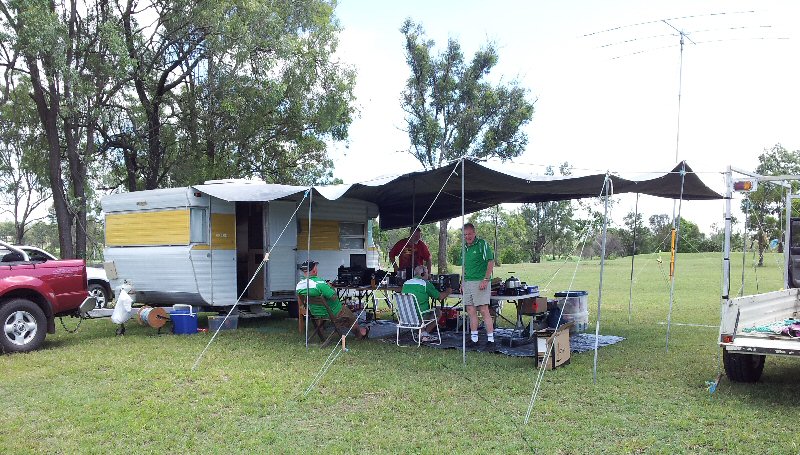 |
Our temporary antenna farm consisted of a 3 element triband yagi mounted on a pump up mast, a G5RV and 160m dipole and a 5 band trapped vertical. The tribander was assembled and the mast and guys laid out then the mast lowered so the rotator and yagi could be lifted into place. With Alan VK4SN perched precariously on a shakey aluminium ladder and Peter VK4MN holding the mast steady the complete assembly was lifted and locked into place and the mast pumped up to operating height. While this was happening Ken VK4QH, Wayne VK4HS and Bob VK4BYX were scouting suitable trees to hold the G5RV and 160m dipole. Ken's strong throwing arm put a light line over the top of some reasonably tall one's along the shore line and soon a heavier rope was in place ready to pull the wires into place. Both the 5 band trapped vertical and the pump up mast holding the tribander were erected on the opposite side of the caravan and tarp area which comprised our operating position and overnight home, some 20m back from the shore line. All antennas up and tied off we assembled and tested our station equipment and power supply systems then sat down for a quick rest awaiting the contest start time of 01:00 UTC. |
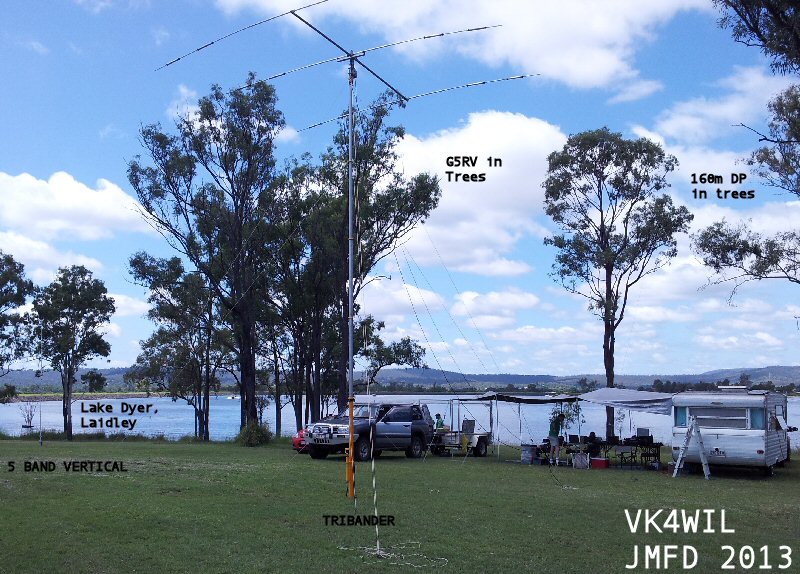 |
Two generators, with a smaller third one in reserve, provided sufficient power for the 4 operating positions along with two sets of twin batteries. Very early on in the contest one bank of batteries were taken offline after it was found they were not supplying sufficient current for that operating position to use 100w and it was then powered directly by one of the generators. As we had five operators but only four operating positions there was always someone available to step in and take over when an operator needed a break. |
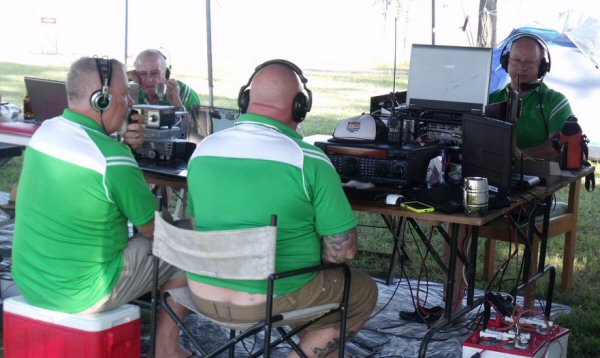 |
L-R of four positions: 15m or 80m, 10 and 160m, 40m, and 20m. |
Conditions proved to be not as favourable as we might have wished for over the contest period but 485 contacts were made to all VK call areas, as well as ZL, Hawaii, the Philippines, China and parts of Europe. Whether it was solely band conditions or lack of contestants is unknown but it seemed that many southern signals were not making the journey in sufficient strength to be reliably worked. Many other contestants were heard to comment that they were unable to copy a particular station that was calling them. General band conditions may have played a significant part as Alan VK4SN made note that a large solar flare (CME) occurred the previous day. 40m was the best performing band which wasn't unexpected as over the distances we were working (within Australia) it was usable both day and night to some part of the country. We had hoped to pick up a lot of contacts on 80m once daylight faded, but this didn't eventuate with just less that a quarter of the 40m contacts made. In previous years the 80m and 40m contacts had almost been neck and neck. |
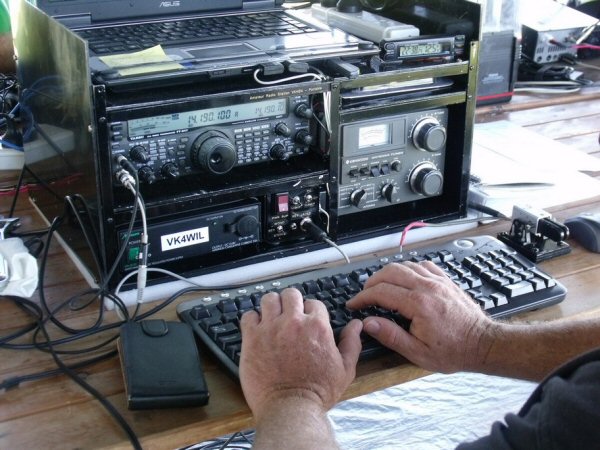 |
The higher bands were also somewhat sparse of signals, at least those that were of main interest to us. Much DX was heard but without linears and higher, high gain antennas, most were deemed to be unworkable. A surprising change to our normal operating was the inclusion of 160m, as in previous years we had not operated on this band. Sideband was where we picked up most of our points with CW providing only 1.85 per cent of the total contacts. We did not operate VHF or UHF as previous years scores for these bands did not sufficiently reward us for the effort we had put into them. |
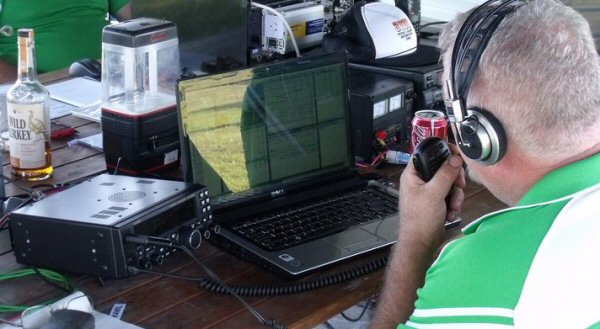 |
|
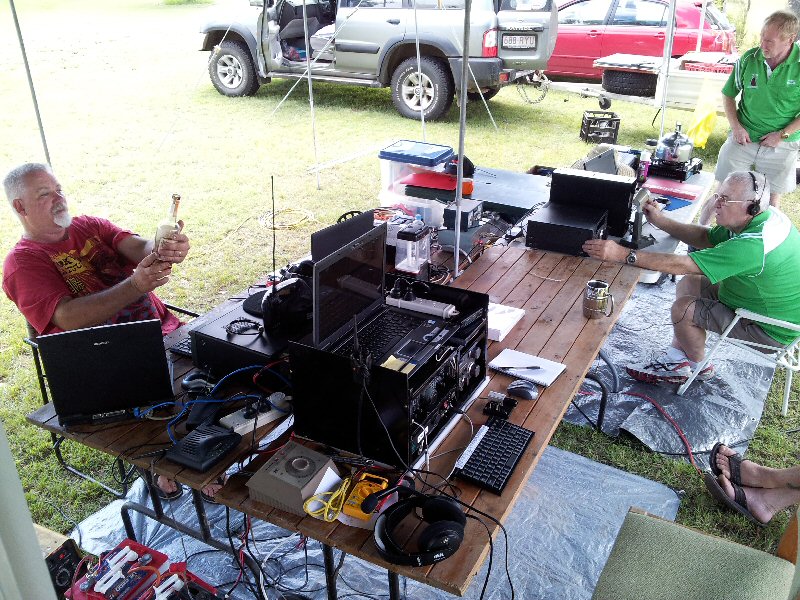 |
|
Vice President - VK4FAKE - Mike Wethereld